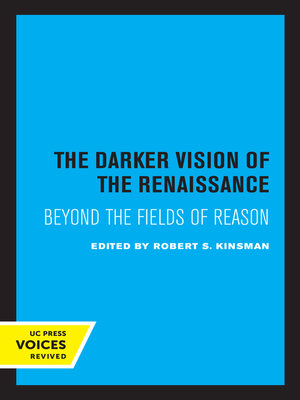
Sign up to save your library
With an OverDrive account, you can save your favorite libraries for at-a-glance information about availability. Find out more about OverDrive accounts.
Find this title in Libby, the library reading app by OverDrive.



Search for a digital library with this title
Title found at these libraries:
| Loading... |
The Darker Vision of the Renaissance explores political, literary, social, religious, medical, and artistic events between 1300 and 1670 that led beyond the bounds of reason into the nonrational, irrational, and suprarational phenomena of the European Renaissance. Robert S. Kinsman's introduction examines Renaissance uses of ratio, "fancy" and "folly," melancholy, anxietas, and alienation. Lynn White Jr. presents the essential thesis of the collection in his view that the years 1300–1650 constituted one of the most psychically disturbed eras ever in European history. The "world-alienation" of the period is analyzed by Donald R. Howard, illustrated by two poems of the late fourteenth century: Gawain and the Green Knight and Toilus and Criseyde. The flourishing of hermetic, magical, cabalistic, and astrological practices in the Renaissance is described by John G. Burke.
The gentleman and courtier's physical and psychological tensions resulting from literal exile or from psychic alienation from his lesser fellows are investigated by Lauro Martines. An analysis of the "structures" of Renaissance mysticism is provided by Kees W. Bolle. Gilbert Reaney's essay examines ratio as the basis for the "measured" music of the fourteenth century, against which the newer duple and triple rhythms that came into prominence in the later half of the century were assessed. An essay by Marc Bensimon concerns itself with Renaissance modes of perception—as illustrated in works of art, of literature, and of philosophic speculation—that seem shaped by primordial anxieties caused by the passing of time and the fear of death. The reflections of theological notions about the "dreadful hidden will of God" in such pieces as Marlowe's Dr. Faustus are given full background and perceptive treatment by Paul R. Sellin. Robert Kinsman concludes with his study "Folly, Melancholy, and Madness: Shifting Styles of Medical Analysis and Treatment, 1450–1675."
This title is part of UC Press's Voices Revived program, which commemorates University of California Press's mission to seek out and cultivate the brightest minds and give them voice, reach, and impact. Drawing on a backlist dating to 1893, Voices Revived makes high-quality, peer-reviewed scholarship accessible once again using print-on-demand technology. This title was originally published in 1974.
The gentleman and courtier's physical and psychological tensions resulting from literal exile or from psychic alienation from his lesser fellows are investigated by Lauro Martines. An analysis of the "structures" of Renaissance mysticism is provided by Kees W. Bolle. Gilbert Reaney's essay examines ratio as the basis for the "measured" music of the fourteenth century, against which the newer duple and triple rhythms that came into prominence in the later half of the century were assessed. An essay by Marc Bensimon concerns itself with Renaissance modes of perception—as illustrated in works of art, of literature, and of philosophic speculation—that seem shaped by primordial anxieties caused by the passing of time and the fear of death. The reflections of theological notions about the "dreadful hidden will of God" in such pieces as Marlowe's Dr. Faustus are given full background and perceptive treatment by Paul R. Sellin. Robert Kinsman concludes with his study "Folly, Melancholy, and Madness: Shifting Styles of Medical Analysis and Treatment, 1450–1675."
This title is part of UC Press's Voices Revived program, which commemorates University of California Press's mission to seek out and cultivate the brightest minds and give them voice, reach, and impact. Drawing on a backlist dating to 1893, Voices Revived makes high-quality, peer-reviewed scholarship accessible once again using print-on-demand technology. This title was originally published in 1974.






